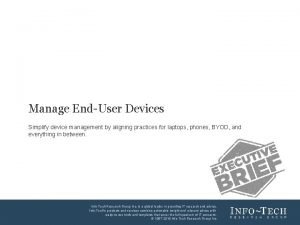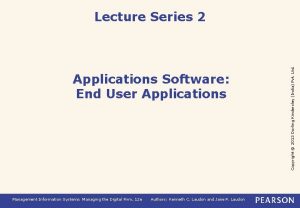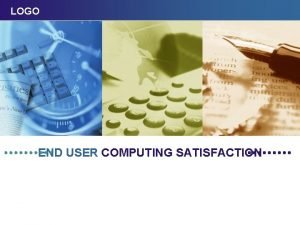Code Development Code development for end user systems















- Slides: 15

Code Development Code development for end user systems

Program Architecture The organization of code components The objective of system architecture is to simplify maintenance by putting code together that will be changed at the same time

Architectural Philosophies Requirements Driven n Data Driven n Dialog Driven n Event Driven n

Coding Standards n Structured Limit control structures to sequence, iteration, and selection n Event Driven Interactive systems driven by user actions n Object oriented Encapsulate data and code into objects that can be called independently

Good Code Maintenance is 80% of the cost of a large system. n Instructions that will be changed together located together. n Errors and bugs isolated. n

Traditional Design n Traditional Life Cycle Approach Formal Methodologies CASE Tools Purchased Systems n New Approaches RAD Evolutionary Code GUI design Object Oriented Design

Good Practice: Loose Coupling Associations among code modules n n Data Control codes Stamp Hybrid code passes only data passes data and control passes information from the structure of the data one module changes the in another

Good Practice: Tight Cohesion Functions done by one code module. A module is a set of code statements that is called and executed together. A cohesive module executes only statements that always go together.

Typical Modules in identified files n Macros and functions n Forms, Reports and Queries n Objects n

Programming Principles n KISS (Keep it Simple, Stupid) Volatility Prototyped code will be revised frequently. Simple solutions are much better than elegant ones that are hard to understand. Clarity over Efficiency EUC systems are usually elective and not run as production code.

Programming Principles n Code should be written to be read Good communication principles White space Boxes Indentation Explain complex logic Modular construction Very simple control structures Mnemonic variables

Programming Principles n Minimize external documentation Document the objective rather than the procedure. The next programmer can find his own solution too. Include descriptive and complete title lines Include an initial statement of program purpose Line comments hard to maintain

Programming Principles n Fully document data files Use labels and file descriptions Use original common data sources where possible Create as few original data tables as possible Document edits and modifications

Programming Principles n Retain natural documentation Keep instructional memos and notes in file Document objectives so that modules can be reprogrammed as needed

References Weinberg, ‘Prototyping and the SDLC’, J Info Systems Mgt, 1991. Chen, Nunamaker, Weber, ‘CASE: present status and future directions’, Database, 1989
 Single user and multi user operating system
Single user and multi user operating system Operating systems
Operating systems Blackberry devices working on january
Blackberry devices working on january End user computing controls examples
End user computing controls examples End user training best practices
End user training best practices Principles for end user computing controls
Principles for end user computing controls End user application software
End user application software End user requirements
End user requirements Pengertian end user
Pengertian end user Gac halal
Gac halal Apa itu end user computing
Apa itu end user computing What is the volume of blood pumped per minute
What is the volume of blood pumped per minute End diastolic volume meaning
End diastolic volume meaning Explain compiler construction tools
Explain compiler construction tools Compiler front end back end
Compiler front end back end Kolondivertikulose definition
Kolondivertikulose definition



























